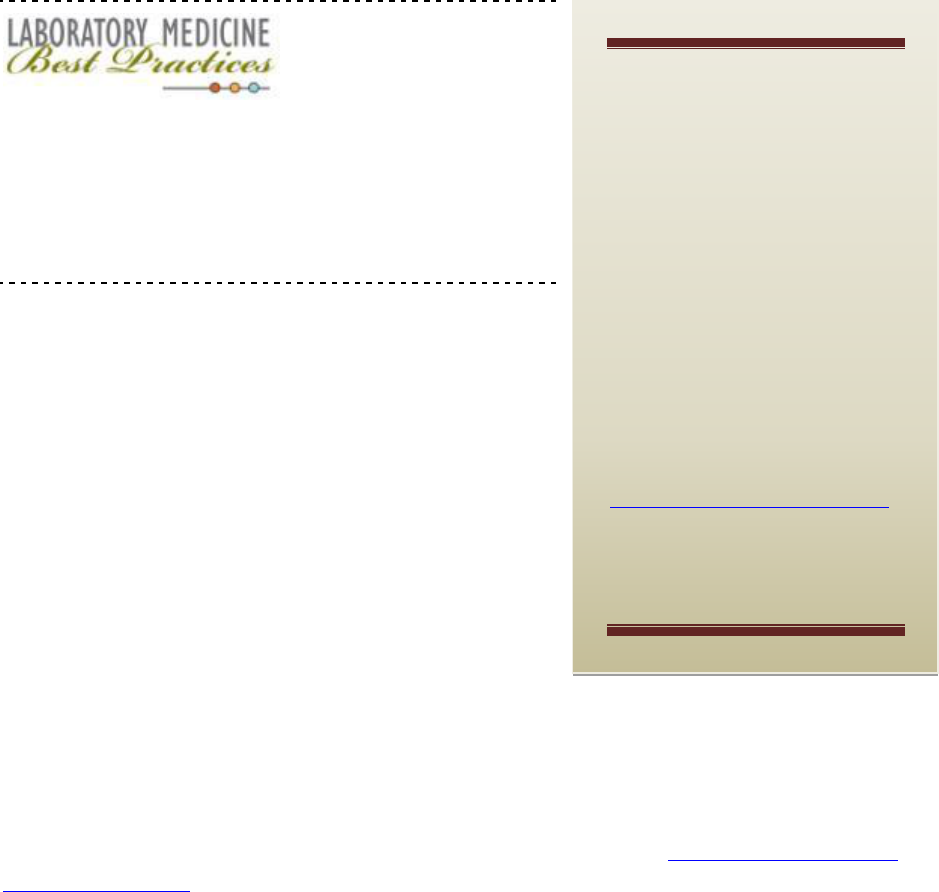
Effective practices for the
timely and accurate reporting
of laboratory testing critical
values
Rapid and accurate communication of critical laboratory test
results is required by the Clinical Laboratory Improvement
Amendments (CLIA) regulations; included in laboratory
accreditation standards; noted as a National Patient Safety
Goal; featured in the World Health Organization's World
Alliance for Patient Safety; and codified in the International
Organization for Standardization standards for medical
laboratories. Improvement in critical value notification is
driven by the assumption that timely reporting will lead to
more timely clinical interventions with improved treatment
outcomes and prevention of co-morbidities. The studies
included in this review assessed the effectiveness of
automated notification systems and call centers to improve the timeliness of critical values reporting.
Summary of LMBP™ Findings and Recommendations
The evidence supporting the use of call centers shows substantial and consistent results in improving
the timeliness of critical value reporting in inpatient care settings, and the Laboratory Medicine Best
Practices Workgroup recommends call centers as an “evidence-based best practice” for improving the
timely reporting of critical values. The evidence, although suggestive, is not sufficient to make an LMBP
recommendation for or against using automated notification systems as a best practice to improve the
timeliness of critical value reporting in inpatient care settings.
About the Interventions and their Comparators
Automated notification systems are automated alerting systems or computerized reminders
using mobile phones, pagers, email or other personal electronic devices to alert the responsible
healthcare provider(s) about laboratory test critical results. Upon receipt of an automated
notification, the responsible provider acknowledges the critical test result and confirms the
receipt of the alert. If the alert is not acknowledged within a specified timeframe, these systems
typically revert to a manual notification system of the responsible and alternate providers.
Through the Laboratory Medicine
Best Practices (LMBP) Initiative,
evidence-based evaluations are
conducted to identify effective
laboratory medicine practices
associated with improved
healthcare quality outcomes.
The LMBP Workgroup and Expert
Panels provide guidance and
subject matter expertise to the
Centers for Disease Control and
Prevention to complete these
reviews.
wwwn.cdc.gov/futurelabmedicine

o Studies have contrasted the timeliness of automated notification systems’ critical test
result reporting with manual (typically, laboratory personnel) notification systems.
Call Centers use a centralized unit for the communication of critical laboratory test results via
telephone contact the responsible caregiver. If the responsible caregiver cannot be reached
within a specified timeframe, call centers will attempt to reach alternative caregivers. Twenty
percent of U.S. medical centers have reported using centralized call centers to communicate
laboratory test critical results.
1
o Studies have contrasted timeliness of call centers’ critical test result reporting with
manual (typically, laboratory personnel) notification systems.
Results from the Systematic Reviews
A total of nine studies met the review inclusion criteria. The estimated effects for both automated
notification systems and call centers consistently and substantially favor the tested practice. All studies
reported positive and statistically significant effects with the exception of one low-powered automated
notification study.
Five studies assessed the improvement in timeliness of critical results communication associated
with call center systems (2 published and 3 unpublished).
o All call center studies were conducted in the United States
o Results from four of the five studies reporting improvement in timeliness from
implementing call centers could be standardized to a common metric. These results
were generally criterion referenced (e.g., percent of critical results reported within 30
minutes), therefore findings were standardized using odds ratios (mean odds ratio (OR =
22.1; 95% CI=17.1–28.6).
Translating this result into a common language estimate, the time to report a
randomly selected critical results using a call center will be faster than a
randomly selected and manually reported critical results approximately 88.6%
of the time.
o The use of call centers may require additional communication with laboratory staff
when a responsible caregiver requires additional information that call center staff are
unable to provide. This situation may result in a delay of treatment while the
appropriate laboratory staff member is located.
Four published studies assessed the improvement in timeliness of critical results communication
associated with automated notification systems.
o These studies were conducted in the USA, Canada, South Korea, Italy, and the Republic
of Singapore.
1
Valenstein PN, W.E., Stankovic AK, Walsh MK, Schneider F., Notification of critical results: a College of American
Pathologists Q-Probes study of 121 institutions. Arch Pathol Lab Med, 2008. 132(12): p. 1862-1867.

o Results from two of the four studies reporting improvement from implementing
automated notification report could be standardized to a common metric. Meta-
analysis of these results suggest that automated notification systems significantly
improve timeliness (standard difference in means (d) = 0.42; 95% CI=0.2–0.62).
Translating this result into a common language estimate, the time to report a
randomly selected critical result using an automated notification system will be
faster than a randomly selected and manually reported critical value
approximately 61.8% of the time.
o The electronic audit trail captured by automated notification systems may improve
performance monitoring and evaluation. In addition, the development of automated
notification systems has been observed to lead to a re-examination of critical results
policies and thresholds.
o Automated notification systems may disrupt usual lines of communication, and may
provide too much or too frequent information. The risk of losing back-up contact
information must be properly anticipated. There are also risks for patient privacy
violations, with protected health information being misdirected and/or mobile
communication devices being accessible to unauthorized users.
o Automated notification systems require policies and procedures that mandate two-way
communication and acknowledgment/confirmation of receipt. Policies for routing and
escalation after unsuccessful notification attempts must be in place, and staff must
remain proficient in the use of manual procedures when a technology failure occurs or
escalation requires that laboratory staff revert to manual contacts.
These results are based on a systematic review of all available studies. This systematic review is
supported by contract CB-11-214 from the Centers for Disease Control and Prevention. Battelle
Memorial Institute provided administrative, research and technical support for this review along with
input from a panel of subject matter experts in laboratory medicine and systematic reviews.
Supporting Materials
Supplementary Data: Evidence summary tables & included studies
Search strategy
Publications
Liebow EB, Derzon JH, Fontanesi J, Favoretto AM, Baetz RA, Shaw C, Thompson P, Mass D,
Christenson R, Snyder SR, Epner P. Effectiveness of Automated Notification and Customer Service
Call Centers for Timely and Accurate Reporting of Critical Values: A Laboratory Medicine Best
Practices Systematic Review and Meta-Analysis. Clin Chem. 2012; 45(13-14):979-987.
Critical Values Clin Biochem 2012.

Disclaimer
The findings and conclusions are those of the authors and do not necessarily represent the official
position of the Centers for Disease Control and Prevention/the Agency for Toxic Substances and Disease
Registry (CDC/ATSDR).
Sample Citation
The content of publications of Laboratory Medicine Best Practices is in the public domain. Citation as to
source, however, is appreciated. Sample citation: Laboratory Medicine Best Practices. Laboratory
Medicine Best Practices. Effective practices for the timely and accurate reporting of critical values
(abbreviated). http://wwwn.cdc.gov/futurelabmedicine/pdfs/CDC_ReportingCriticalValuesSummary.pdf.
Last updated: MM/DD/YYYY
Review completed: February 2012.
